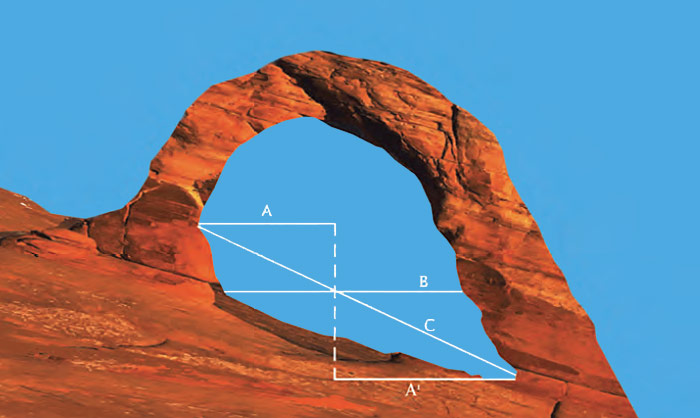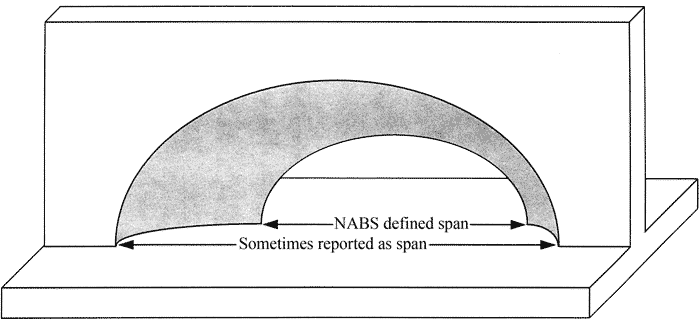
A Tour of the Big 19
Photos and information on the world's giant natural arches
by David Brandt-Erichsen and Jay Wilbur
Introduction

On this page the Natural Arch and Bridge Society (NABS) lists all the natural arches in the world we know about that have spans greater than 200 feet. Placement on this list is based on the best data currently available to us and is subject to change pending more accurate measurements. Indeed, the ranking on this page has changed thirteen times since this page was first created, and further changes are fairly likely in the future, especially as additional data is obtained for arches that are outside the United States. Note: The differences between the spans of some adjacent arches on the list are less than the margin of error of the measurements. Therefore, the ranking presented here must be considered approximate rather than exact.
To accurately compare the sizes of natural arches, two things are needed: (1) agreement on just what points to measure, and (2) accurate measurements from those agreed-upon points. Without agreement on what points to measure, different people taking measurements may get very different results no matter how accurately the measurements are taken.
In the table below, ranking is based solely on the criterion of greatest span, where span is a dimension defined so that arches of different geometries can be consistently and accurately compared (see below for further explanation). The web pages indexed by the table below include photographs and information about each of these giant arches. You can directly link to each arch, or page through them sequentially.
Note that of the 19 known natural arches that are greater than 200 feet in span, nine are in China and nine are in the Colorado Plateau. Although we are indebted to many people who have contributed to the information on these pages, special mention should be made of Gunter Welz, who reported the measurements for nine of the eleven arches outside the United States that are on this list.
The natural arches with known spans greater than 200 feet are:
Rank |
Image |
Name |
Location |
Span |
|
1 |
Buliu River, Guangxi, China |
400 ft |
||
|
2 |
Zhijin Cave Scenic Area, Guizhou, China |
340 ft |
||
|
3? |
Jiangzhou, Guangxi, China |
280- 340 ft |
||
|
4 |
Guizhou Province, China |
300 ft |
||
|
5 |
Arches National Park, Utah |
290 ft |
||
|
6 |
Zion National Park, Utah
|
287 ft |
||
|
7 |
Guizhou Province, China | 251 ft |
||
|
8 |
Ennedi Range, Chad (Sahara Desert) | 250 ft |
||
|
9 |
Moab, Utah |
243 ft |
||
|
10 |
Bazhou He Scenic Area, Guizhou, China |
240 ft |
||
|
11 |
Rainbow Bridge National Monument, Utah |
234 ft |
||
|
12 |
Getu Valley National Park, Guizhou, China |
230 ft |
||
|
13 |
Natural Bridges National Monument, Utah |
225 ft |
||
|
14 |
Escalante River, Utah
|
220 ft |
||
|
15
|
Near Kashgar, Xinjiang, China |
214 ft |
||
|
16
|
Near Zunyi, Guizhou, China |
213 ft |
||
|
17
|
Bamyan Province, Afghanistan |
211 ft |
||
|
18 |
Dinosaur National
Monument, Colorado |
206 ft |
||
|
19
|
Sanostee, New Mexico |
204 ft |
How Are Arch Sizes Compared?
Readers should note that this is not a list of the "largest" natural arches for the simple reason that there is no precise definition of "largest" that would apply to the many different geometries displayed by natural arches. What criteria would you use for "largest" — width, height, area, volume? (The latter two would be impractical to measure as well as difficult to precisely define.) And at exactly what points would you take the measurements?
To attempt to answer these questions, the Natural Arch and Bridge Society assembled a working group of experts (including geologists, physical geographers, a physicist, and a mathematician) to come up with a set of standards and definitions for measuring natural arches. The results (some are quite technical) can be found in our Arch Info pages. No other system currently exists that permits consistent and accurate comparison of the sizes of natural arches.
For our purposes here, a less technical (and less precise) definition of the span of an arch is the horizontal extent of unsupported rock. The two illustrations below will help in understanding just what this means.

Illustration courtesy Utah Geological Survey
In the illustration above, the span would be the sum of the horizontal lines A and A'. Since this arch is not symmetrical, the span cannot be measured directly in a single line. Measuring B or C would produce quite different results.

The illustration above shows a three-dimensional view of an arch in which the dimensions differ considerably between the "front" and the "back" of the arch, which can result in wide discrepancies in reported spans. In this case, the NABS-defined span would be the maximum horizontal dimension of the most constrained part of the opening, as shown. The advantage of the NABS system of measurement is that it can be applied to arches of any geometry and will always produce consistent results. For more information, see the article on Finding the Span of Arches with Simple Shapes.
Development of this List
In October 2010 a NABS group confirmed that Fairy Bridge in China has the greatest span in the world. For many years the only two known contenders for this position were Landscape Arch in Arches National Park and Kolob Arch in Zion National Park. The most precise measurement of Landscape Arch was obtained in 2004, and the most precise measurement of Kolob Arch was obtained in 2006, finally establishing Landscape Arch as having the greater span (by a mere three feet). Fairy Bridge is now known to exceed this dimension by a surprisingly large margin (see Measurement of Fairy Bridge).
This list has a long tradition. In his 1986 book Utah Canyon Country, Fran Barnes provided a list of nine arches that were 200 feet or more in span. The list was confined to the Colorado Plateau, but no arches of that size outside the Colorado Plateau were then known. When this web page was first created in 1995, one arch from Barnes’ list (Owachomo Natural Bridge) was dropped, and another arch (Snake Bridge) was added. Here are some of the major changes to this page since it was first created:
- 2004: Aloba Arch measured and confirmed to be over 200 feet.
- 2006: Outlaw Arch discovered. See SPAN April 2007.
- 2007: Kachina Natural Bridge removed from list when a precision laser measurement found that it was less than 200 feet.
- 2009: Wrather Arch removed from list when a new measurement showed the span was less than 200 feet.
- 2009: Information obtained on four natural arches in China that are over 200 feet: Fairy Bridge, Jiangzhou, Gaotun, and Shiptons Arch (Tushuk Tash). See SPAN July 2009.
- 2010: Fairy Bridge confirmed as longest arch in the world; Jiangzhou Immortal Bridge found to be a contender for second place. See SPAN Winter 2011.
- 2011: Hazarchishma Natural Bridge in Afghanistan reported and measured at over 200 feet. See SPAN Spring 2011.
- 2013: Two more arches in China measured at over 200 feet: Zhijin and Yunmentum. See SPAN Winter 2014.
- 2015: Three more arches in China measured at over 200 feet: Dachuandong, Qingxudong, and Getu. See SPAN Fall 2015.
Other Potential Candidates
It is fairly likely that this list will change again in the future. There may be additional giant arches still unknown to westerners in various parts of the world, especially the vast karst regions of China. Below are three possible contenders and we would appreciate any additional information about these arches. If you can help, please email info@naturalarches.org.
 |
Mystery arch in Namibia. We do not have a specific location for this arch and have not been able to find it. It has been reported at 246 feet but the report is in question. |
 |
Chuanlongyan Through-Cave, China (reference 1, reference 2). There is a road and parking lot inside and the extensive construction makes it difficult to determine if the original span might have been widened. |
 |
Now start your Big 19 Tour with a trip |



















